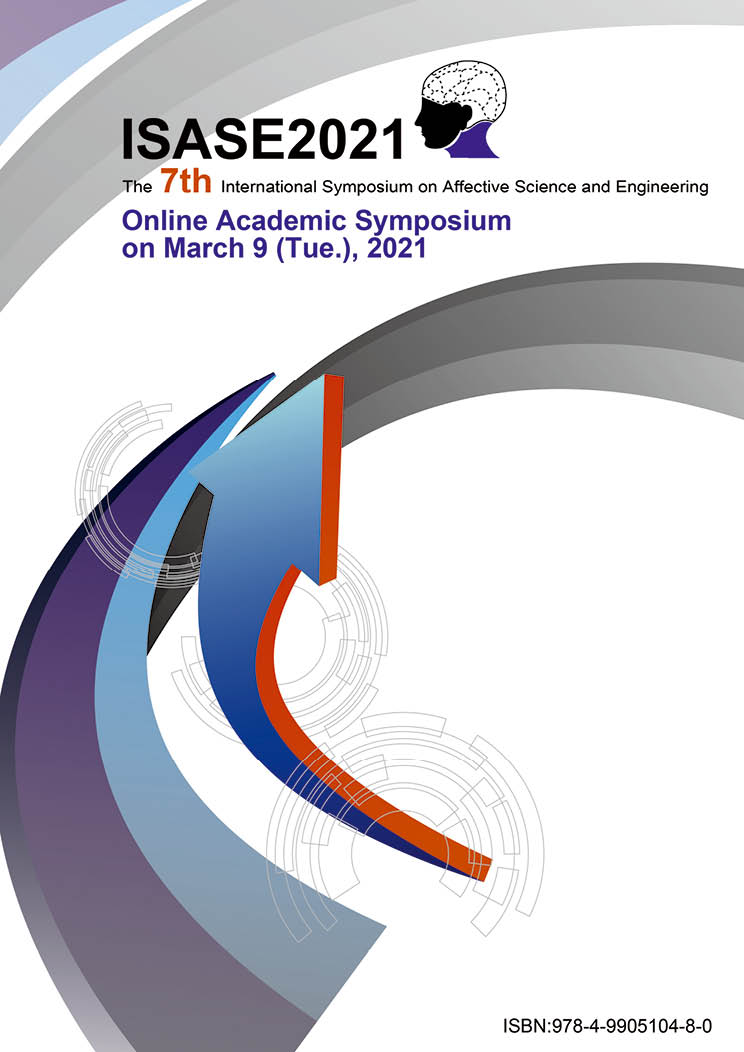ISASE2021
選択された号の論文の30件中1~30を表示しています
- |<
- <
- 1
- >
- >|
6A: Affective Science & Engineering
-
セッションID: 6A-01
発行日: 2021年
公開日: 2021/05/31
PDF形式でダウンロード (344K) -
セッションID: 6A-02
発行日: 2021年
公開日: 2021/05/31
PDF形式でダウンロード (308K) -
セッションID: 6A-03
発行日: 2021年
公開日: 2021/05/31
PDF形式でダウンロード (535K) -
セッションID: 6A-04
発行日: 2021年
公開日: 2021/05/31
PDF形式でダウンロード (964K) -
セッションID: 6A-05
発行日: 2021年
公開日: 2021/05/31
PDF形式でダウンロード (458K) -
セッションID: 6A-06
発行日: 2021年
公開日: 2021/05/31
PDF形式でダウンロード (282K)
6B: Affective Education & Marketing
-
セッションID: 6B-01
発行日: 2021年
公開日: 2021/05/31
PDF形式でダウンロード (376K) -
セッションID: 6B-02
発行日: 2021年
公開日: 2021/05/31
PDF形式でダウンロード (1385K) -
セッションID: 6B-03
発行日: 2021年
公開日: 2021/05/31
PDF形式でダウンロード (721K) -
セッションID: 6B-04
発行日: 2021年
公開日: 2021/05/31
PDF形式でダウンロード (339K) -
セッションID: 6B-05
発行日: 2021年
公開日: 2021/05/31
PDF形式でダウンロード (698K) -
セッションID: 6B-06
発行日: 2021年
公開日: 2021/05/31
PDF形式でダウンロード (644K)
7A: Affective Computing
-
セッションID: 7A-01
発行日: 2021年
公開日: 2021/05/31
PDF形式でダウンロード (431K) -
セッションID: 7A-02
発行日: 2021年
公開日: 2021/05/31
PDF形式でダウンロード (476K) -
セッションID: 7A-03
発行日: 2021年
公開日: 2021/05/31
PDF形式でダウンロード (428K) -
セッションID: 7A-04
発行日: 2021年
公開日: 2021/05/31
PDF形式でダウンロード (344K) -
セッションID: 7A-05
発行日: 2021年
公開日: 2021/05/31
PDF形式でダウンロード (317K) -
セッションID: 7A-06
発行日: 2021年
公開日: 2021/05/31
PDF形式でダウンロード (764K)
7B: Affective Design
-
セッションID: 7B-01
発行日: 2021年
公開日: 2021/05/31
PDF形式でダウンロード (171K) -
セッションID: 7B-02
発行日: 2021年
公開日: 2021/05/31
PDF形式でダウンロード (289K) -
セッションID: 7B-03
発行日: 2021年
公開日: 2021/05/31
PDF形式でダウンロード (4816K) -
セッションID: 7B-04
発行日: 2021年
公開日: 2021/05/31
PDF形式でダウンロード (864K) -
セッションID: 7B-05
発行日: 2021年
公開日: 2021/05/31
PDF形式でダウンロード (811K) -
セッションID: 7B-06
発行日: 2021年
公開日: 2021/05/31
PDF形式でダウンロード (3556K)
8A: Affective Measurement
-
Unconstrained Respiration States Classification by Detecting Respiratory Cycle Using AutocorrelationセッションID: 8A-01
発行日: 2021年
公開日: 2021/05/31
PDF形式でダウンロード (633K) -
セッションID: 8A-02
発行日: 2021年
公開日: 2021/05/31
PDF形式でダウンロード (341K) -
Bayesian Explanation of the Effects of Tactile Feedback on the Affective Evaluation of Switch SoundsセッションID: 8A-03
発行日: 2021年
公開日: 2021/05/31
PDF形式でダウンロード (951K) -
セッションID: 8A-04
発行日: 2021年
公開日: 2021/05/31
PDF形式でダウンロード (748K) -
セッションID: 8A-05
発行日: 2021年
公開日: 2021/05/31
PDF形式でダウンロード (286K) -
セッションID: 8A-06
発行日: 2021年
公開日: 2021/05/31
PDF形式でダウンロード (532K)
- |<
- <
- 1
- >
- >|
